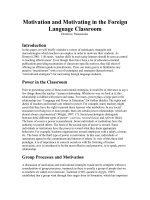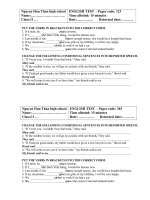Bias, Confounding and Fallacies in Epidemiology
Bạn đang xem bản rút gọn của tài liệu. Xem và tải ngay bản đầy đủ của tài liệu tại đây (1.01 MB, 67 trang )
<span class="text_page_counter">Trang 1</span><div class="page_container" data-page="1">
<b>Bias, Confounding and Fallacies in Epidemiology</b>
<b>M. Tevfik DORAK</b>
<b>o/epi</b>
</div><span class="text_page_counter">Trang 3</span><div class="page_container" data-page="3"><b>Bias is one of the three major threats to internal </b>
</div><span class="text_page_counter">Trang 4</span><div class="page_container" data-page="4"><b>Any trend in the collection, analysis, interpretation, publication or review of data that can lead to conclusions that are systematically different from </b>
<b>the truth (Last, 2001)</b>
<b>A process at any state of inference tending to produce results that depart systematically from </b>
<b>the true values (Fletcher et al, 1988)</b>
<b>Systematic error in design or conduct of a study (Szklo et al, 2000)</b>
<b>What is Bias? </b>
</div><span class="text_page_counter">Trang 5</span><div class="page_container" data-page="5"><b>Errors can be differential (systematic) or non-differential (random)</b>
<b>Random error: use of invalid outcome </b>
<b>measure that equally misclassifies cases and controls</b>
<b>Differential error: use of an invalid measures that misclassifies cases in one direction and misclassifies controls in another</b>
<b>Term '</b><i><b>bias</b></i><b>' should be reserved for differential or systematic error </b>
<b>Bias is systematic error</b>
</div><span class="text_page_counter">Trang 8</span><div class="page_container" data-page="8"><b>Chance vs Bias</b>
<b>Chance is caused by random errorBias is caused by systematic error</b>
<b>Errors from chance will cancel each other out in the long run (large sample size)</b>
<b>Errors from bias will not cancel each other out whatever the sample size</b>
<b>Chance leads to imprecise resultsBias leads to inaccurate results</b>
</div><span class="text_page_counter">Trang 9</span><div class="page_container" data-page="9"><i><b>Selection bias</b></i>
<b>Unrepresentative nature of sample</b>
<i><b>Information (misclassification) bias</b></i>
<b>Errors in measurement of exposure of disease</b>
<i><b>Confounding bias</b></i>
<b>Distortion of exposure - disease relation by some other factor</b>
<b>Types of bias not mutually exclusive</b>
<i><b>(effect modification is not bias)</b></i>
<b><small>This classification is by Miettinen OS in 1970sSee for example Miettinen & Cook, 1981 (www)</small></b>
<b>Types of Bias </b>
</div><span class="text_page_counter">Trang 10</span><div class="page_container" data-page="10"><b>Selection Bias</b>
<b>Selective differences between comparison groups that impacts on relationship between exposure </b>
<b>and outcome</b>
<i><b>Usually results from comparative groups not coming from the same study base and not being </b></i>
<b>representative of the populations they come from</b>
</div><span class="text_page_counter">Trang 11</span><div class="page_container" data-page="11"><b>Selection Bias Examples</b>
</div><span class="text_page_counter">Trang 12</span><div class="page_container" data-page="12"><b>Selection Bias Examples</b>
</div><span class="text_page_counter">Trang 13</span><div class="page_container" data-page="13"><b>Selection Bias Examples</b>
</div><span class="text_page_counter">Trang 14</span><div class="page_container" data-page="14"><b>Selection Bias Examples</b>
</div><span class="text_page_counter">Trang 15</span><div class="page_container" data-page="15"><b>Selection Bias Examples</b>
<b><small>Selective survival (Neyman's) bias</small></b>
</div><span class="text_page_counter">Trang 16</span><div class="page_container" data-page="16"><b>Selection Bias Examples</b>
<b>Case-control study:</b>
<b>Controls have less potential for exposure than casesOutcome = brain tumour; exposure = overhead high voltage power lines</b>
<b>Cases chosen from province wide cancer registryControls chosen from rural areas</b>
<b>Systematic differences between cases and controls</b>
</div><span class="text_page_counter">Trang 17</span><div class="page_container" data-page="17"><b>Case-Control Studies: Potential Bias</b>
<b><small>Schulz & Grimes, 2002 (www) (PDF)</small></b>
</div><span class="text_page_counter">Trang 18</span><div class="page_container" data-page="18"><b>Selection Bias Examples</b>
<b>Cohort study:</b>
<b>Differential loss to follow-up</b>
<b>Especially problematic in cohort studies</b>
<b>Subjects in follow-up study of multiple sclerosis may differentially drop out due to disease severity</b>
<b>Differential attrition selection bias</b>
</div><span class="text_page_counter">Trang 19</span><div class="page_container" data-page="19"><b>Selection Bias Examples</b>
<b>Self-selection bias:</b>
<b>- You want to determine the prevalence of HIV infection- You ask for volunteers for testing</b>
<b>- You find no HIV</b>
<b>- Is it correct to conclude that there is no HIV in this location?</b>
</div><span class="text_page_counter">Trang 20</span><div class="page_container" data-page="20"><b>Selection Bias Examples</b>
<b>Healthy worker effect:</b>
<b> Another form of self-selection bias</b>
<b>“self-screening” process – people who are unhealthy “screen” themselves out of active worker populationExample: </b>
<b>- Course of recovery from low back injuries in 25-45 year olds</b>
<b>- Data captured on worker’s compensation records</b>
<b>- But prior to identifying subjects for study, self-selection has already taken place</b>
</div><span class="text_page_counter">Trang 21</span><div class="page_container" data-page="21"><b>Selection Bias Examples</b>
<b>Diagnostic or workup bias:</b>
<b>Also occurs before subjects are identified for studyDiagnoses (case selection) may be influenced by physician’s knowledge of exposure</b>
<b>- Case control study – outcome is pulmonary disease, exposure is smoking</b>
<b>- Radiologist aware of patient’s smoking status when reading x-ray – may look more carefully for </b>
<b>abnormalities on x-ray and differentially select casesLegitimate for clinical decisions, inconvenient for research</b>
</div><span class="text_page_counter">Trang 22</span><div class="page_container" data-page="22"><i><b>Selection bias</b></i>
<b>Unrepresentative nature of sample</b>
<i><b>** Information (misclassification) bias **</b></i>
<b>Errors in measurement of exposure of disease</b>
<i><b>Confounding bias</b></i>
<b>Distortion of exposure - disease relation by some other factor</b>
<b>Types of Bias </b>
</div><span class="text_page_counter">Trang 23</span><div class="page_container" data-page="23"><b>Information / Measurement / Misclassification Bias </b>
<b>Method of gathering information is inappropriate and yields systematic errors in measurement of exposures or outcomes</b>
<b>If misclassification of exposure (or disease) is unrelated to disease (or exposure) then the misclassification is </b><i><b>non-differential</b></i>
<b>If misclassification of exposure (or disease) is related to disease (or exposure) then the misclassification is </b>
<b>Distorts the true strength of association</b>
</div><span class="text_page_counter">Trang 25</span><div class="page_container" data-page="25"><b>Information / Measurement / Misclassification Bias </b>
<b>Recall bias: </b>
<b>Those exposed have a greater sensitivity for recalling exposure (reduced specificity)</b>
<b> - specifically important in case-control studies</b>
<b>- when exposure history is obtained retrospectivelycases may more closely scrutinize their past history looking for ways to explain their illness</b>
<b>- controls, not feeling a burden of disease, may less closely examine their past history </b>
<b>Those who develop a cold are more likely to identify the exposure than those who do not – differential misclassification</b>
<b> - Case: Yes, I was sneezed on </b>
<b> - Control: No, can’t remember any sneezing</b>
</div><span class="text_page_counter">Trang 26</span><div class="page_container" data-page="26"><b>Information / Measurement / Misclassification Bias </b>
<b>Reporting bias: </b>
<b>Individuals with severe disease tends to have complete records therefore more complete </b>
<b>information about exposures and greater association found</b>
<b>Individuals who are aware of being participants of a study behave differently (Hawthorne effect)</b>
</div><span class="text_page_counter">Trang 27</span><div class="page_container" data-page="27"><b>Controlling for Information Bias </b>
<b> - Blinding </b>
<b>prevents investigators and interviewers from knowing case/control or exposed/non-exposed status of a given participant</b>
<b> - Form of survey </b>
<b>mail may impose less “white coat tension” than a phone or face-to-face interview</b>
<b>- Questionnaire</b>
<b> use multiple questions that ask same information acts as a built in double-check</b>
<b>- Accuracy</b>
<b> multiple checks in medical records </b>
<b>gathering diagnosis data from multiple sources</b>
</div><span class="text_page_counter">Trang 28</span><div class="page_container" data-page="28"><i><b>Selection bias</b></i>
<b>Unrepresentative nature of sample</b>
<i><b>Information (misclassification) bias</b></i>
<b>Errors in measurement of exposure of disease</b>
<i><b>** Confounding bias **</b></i>
<b>Distortion of exposure - disease relation by some other factor</b>
<b>Types of Bias </b>
</div><span class="text_page_counter">Trang 30</span><div class="page_container" data-page="30"><b>Cases of Down Syndrome by Birth Order</b>
</div><span class="text_page_counter">Trang 31</span><div class="page_container" data-page="31"><b>Cases of Down Syndrome by Age Groups</b>
</div><span class="text_page_counter">Trang 32</span><div class="page_container" data-page="32"><b>Cases of Down Syndrome by Birth Orderand Maternal Age</b>
</div><span class="text_page_counter">Trang 33</span><div class="page_container" data-page="33"><b>• A third factor which is related to both </b>
<b>exposure and outcome, and which accounts for some/all of the observed relationship </b>
<b>between the two</b>
<b>• Confounder not a result of the exposure</b>
<b>– e.g., association between child’s birth rank </b>
<b>(exposure) and Down syndrome (outcome); mother’s age a confounder?</b>
<b>– e.g., association between mother’s age (exposure) </b>
<b>and Down syndrome (outcome); birth rank a confounder?</b>
<b>Confounding</b>
</div><span class="text_page_counter">Trang 34</span><div class="page_container" data-page="34"><b>Exposure Outcome</b>
<b>Third variable</b>
<b>To be a confounding factor, two conditions must be met:</b>
<b>Be associated with exposure</b>
<b> - without being the consequence of exposure</b>
<b>Confounding</b>
</div><span class="text_page_counter">Trang 35</span><div class="page_container" data-page="35"><b>Birth Order Down Syndrome</b>
<b>Maternal Age</b>
<b>Maternal age is correlated with birth order and a risk factor even if birth order </b>
<b>is low</b>
</div><span class="text_page_counter">Trang 36</span><div class="page_container" data-page="36"><b>Birth Order </b>
<b> Down SyndromeMaternal Age</b>
<b>Confounding ?</b>
<b>Birth order is correlated with maternal age but not a risk factor in younger mothers</b>
</div><span class="text_page_counter">Trang 37</span><div class="page_container" data-page="37"><b>Coffee CHD</b>
<b>Smoking is correlated with coffee </b>
<b>drinking and a risk factor even for those who do not drink coffee</b>
</div><span class="text_page_counter">Trang 38</span><div class="page_container" data-page="38"><b>Coffee </b>
<b> CHDSmoking</b>
<b>Confounding ?</b>
<b>Coffee drinking may be correlated with smoking but is not a risk factor in </b>
</div><span class="text_page_counter">Trang 39</span><div class="page_container" data-page="39"><b>non-Alcohol Lung Cancer</b>
<b>Smoking is correlated with alcohol consumption and a risk factor even for </b>
<b>those who do not drink alcohol</b>
</div><span class="text_page_counter">Trang 40</span><div class="page_container" data-page="40"><b>Smoking CHD</b>
<b>Yellow fingers</b>
<b>Not related to the outcome</b>
<b>Confounding ?</b>
</div><span class="text_page_counter">Trang 42</span><div class="page_container" data-page="42"><b>Imagine you have repeated a positive finding of birth order </b>
<b>association in Down syndrome or association of coffee drinking with CHD in another sample. Would you be able to replicate it? If not why? </b>
<b>Imagine you have included only non-smokers in a study and examined association of alcohol with lung cancer. Would you find an association? </b>
<b>Imagine you have stratified your dataset for smoking status in the alcohol - lung cancer association study. Would the odds ratios differ in the two strata? </b>
</div><span class="text_page_counter">Trang 43</span><div class="page_container" data-page="43"><b>Imagine you have repeated a positive finding of birth order </b>
<b>association in Down syndrome or association of coffee drinking with CHD in another sample. Would you be able to replicate it? If not why? </b>
<b>You would not necessarily be able to replicate the original finding because it was a spurious association</b>
<b>due to confounding. </b>
<b>In another sample where all mothers are below 30 yr, there would be no association with birth order. </b>
<b>In another sample in which there are few smokers, the coffee association with CHD would not be </b>
<b>replicated.</b>
</div><span class="text_page_counter">Trang 44</span><div class="page_container" data-page="44"><b>Imagine you have included only non-smokers in a study and examined association of alcohol with lung cancer. Would you find an association? </b>
<b>No because the first study was confounded. The </b>
<b>association with alcohol was actually due to smoking. By restricting the study to non-smokers, we have </b>
<b>found the truth. Restriction is one way of preventing confounding at the time of study design. </b>
</div><span class="text_page_counter">Trang 45</span><div class="page_container" data-page="45"><b>Imagine you have stratified your dataset for smoking status in the alcohol - lung cancer association study. Would the odds ratios differ in the two strata? </b>
<b>The alcohol association would yield the similar odds ratio in both strata and would be close to unity. In confounding, the stratum-specific odds ratios should be similar and different from the crude odds ratio by at least 15%. Stratification is one way of identifying </b>
<b>confounding at the time of analysis. </b>
<b>If the stratum-specific odds ratios are different, then </b>
</div><span class="text_page_counter">Trang 46</span><div class="page_container" data-page="46"><b>If the smoking is included in the statistical model, the alcohol association would lose its statistical </b>
<b>significance. Adjustment by multivariable modelling is another method to identify confounders at the time of data analysis. </b>
<b>Imagine you have tried to adjust your alcohol association for smoking status (in a statistical model). Would you see an </b>
<b>association? </b>
</div><span class="text_page_counter">Trang 47</span><div class="page_container" data-page="47"><b>For confounding to occur, the confounders should be differentially represented in the comparison groups. </b>
<b>Randomisation is an attempt to evenly distribute </b>
<b>potential (unknown) confounders in study groups. It does not guarantee control of confounding. </b>
<b>Matching is another way of achieving the same. It ensures equal representation of subjects with known confounders in study groups. It has to be coupled with matched analysis.</b>
<b>Restriction for potential confounders in design also prevents confounding but causes loss of statistical power (instead stratified analysis may be tried).</b>
</div><span class="text_page_counter">Trang 48</span><div class="page_container" data-page="48"><b>Randomisation, matching and restriction can be tried at the time of designing a study to reduce the risk of </b>
<b>confounding. </b>
<b>At the time of analysis:</b>
<b>Stratification and multivariable (adjusted) analysis can achieve the same. </b>
<b>It is preferable to try something at the time of designing the study.</b>
</div><span class="text_page_counter">Trang 49</span><div class="page_container" data-page="49"><b>Effect of randomisation on outcome of trials in acute pain</b>
</div><span class="text_page_counter">Trang 50</span><div class="page_container" data-page="50"><b>Obesity Mastitis</b>
<b>In cows, older ones are heavier and older age increases the risk for mastitis. This </b>
</div><span class="text_page_counter">Trang 51</span><div class="page_container" data-page="51"><b><small>If each case is matched with a same-age control, there will be no </small></b>
<i><b><small>association (OR for old age = 2.6, P = 0.0001)</small></b></i>
</div><span class="text_page_counter">Trang 52</span><div class="page_container" data-page="52"><b>No Confounding</b>
</div><span class="text_page_counter">Trang 53</span><div class="page_container" data-page="53"><b>Cases of Down Syndrome by Birth Orderand Maternal Age</b>
<b><small>If each case is matched with a same-age control, there will be no association. If analysis is repeated after stratification by age, there </small></b>
<b><small>will be no association with birth order. </small></b>
</div><span class="text_page_counter">Trang 55</span><div class="page_container" data-page="55"><b>Confounding or Effect Modification</b>
<b>Birth WeightLeukaemiaSex</b>
<b>Can sex be responsible for the birth weight association in leukaemia? </b>
<b> - Is it correlated with birth weight?</b>
<b> - Is it correlated with leukaemia independently of birth weight? </b>
<b> - Is it on the causal pathway? </b>
<b> - Can it be associated with leukaemia even if birth weight is low? </b>
<b> - Is sex distribution uneven in comparison groups?</b>
</div><span class="text_page_counter">Trang 56</span><div class="page_container" data-page="56"><b>Confounding or Effect Modification</b>
<b>Birth WeightLeukaemiaSex</b>
<b>Does birth weight association differ in strength according to sex? Birth WeightLeukaemia</b>
<b><small>OR = 1.5</small></b>
</div><span class="text_page_counter">Trang 57</span><div class="page_container" data-page="57"><b>Effect Modification</b>
<b>In an association study, if the strength of the </b>
<b>association varies over different categories of a third variable, this is called effect modification. The third </b>
<b>variable is changing the effect of the exposure. </b>
<b>The effect modifier may be sex, age, an environmental exposure or a genetic effect. </b>
<b>Effect modification is similar to interaction in statistics. There is no adjustment for effect modification. Once it </b>
<b>is detected, stratified analysis can be used to obtain stratum-specific odds ratios. </b>
</div><span class="text_page_counter">Trang 58</span><div class="page_container" data-page="58"><b>Increases knowledge of biological mechanismAllows targeting of public health action</b>
</div><span class="text_page_counter">Trang 61</span><div class="page_container" data-page="61"><b>HOW TO CONTROL FOR CONFOUNDERS?</b>
• IN STUDY DESIGN…
– RESTRICTION of subjects according to potential
confounders (i.e. simply don’t include confounder in study)
– RANDOM ALLOCATION of subjects to study groups to attempt to even out unknown confounders
– MATCHING subjects on potential confounder thus assuring even distribution among study groups
</div><span class="text_page_counter">Trang 62</span><div class="page_container" data-page="62"><b>HOW TO CONTROL FOR CONFOUNDERS?</b>
• IN DATA ANALYSIS…
– STRATIFIED ANALYSIS using the Mantel Haenszel method to adjust for confounders
– IMPLEMENT A MATCHED-DESIGN after you have collected data (frequency or group)
– RESTRICTION is still possible at the analysis stage but it means throwing away data
</div><span class="text_page_counter">Trang 63</span><div class="page_container" data-page="63"><b>Effect of blinding on outcome of trials of acupuncture for chronic back pain</b>
</div><span class="text_page_counter">Trang 64</span><div class="page_container" data-page="64"><b>WILL ROGERS' PHENOMENON </b>
<b><small>Assume that you are tabulating survival for patients with a certain type of tumour. You separately track survival of patients whose cancer has </small></b>
<b><small>metastasized and survival of patients whose cancer remains localized. As you would expect, average survival is longer for the patients without metastases. </small></b>
<b><small>Now a fancier scanner becomes available, making it possible to detect </small></b>
<b><small>metastases earlier. What happens to the survival of patients in the two groups? The group of patients without metastases is now smaller. The patients who are </small></b>
<b><small>removed from the group are those with small metastases that could not have been detected without the new technology. These patients tend to die sooner </small></b>
<b><small>than the patients without detectable metastases. By taking away these patients, the average survival of the patients remaining in the "no metastases" </small></b>
<b><small>group will improve. </small></b>
<b><small>What about the other group? The group of patients with metastases is now larger. The additional patients, however, are those with small metastases. These patients tend to live longer than patients with larger metastases. Thus </small></b>
<b><small>the average survival of all patients in the "with-metastases" group will </small></b>
</div><span class="text_page_counter">Trang 65</span><div class="page_container" data-page="65"><b>Cause-and-Effect Relationship</b>
</div><span class="text_page_counter">Trang 67</span><div class="page_container" data-page="67"><b>M. Tevfik DORAK</b>
<b>Paediatric & Lifecourse Epidemiology Research GroupSchool of Clinical Medical Sciences (Child Health)</b>
<b>Newcastle UniversityEngland, U.K.</b>
<b>o</b>
</div>








